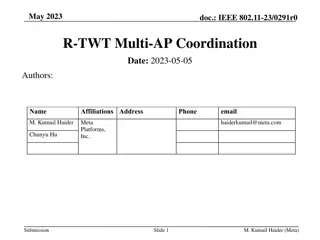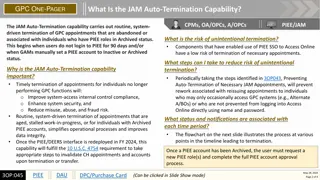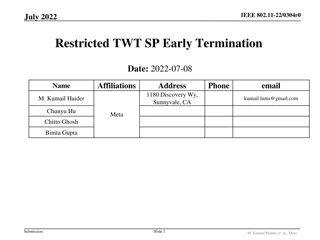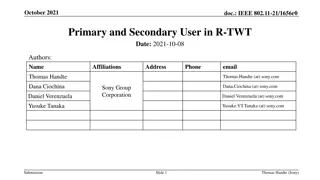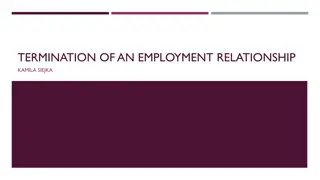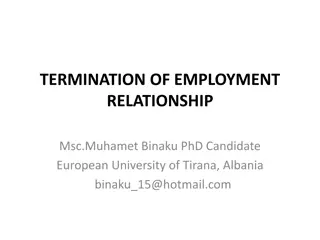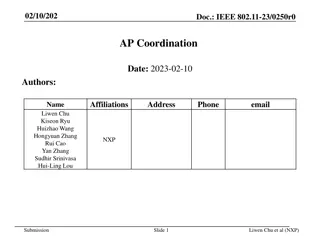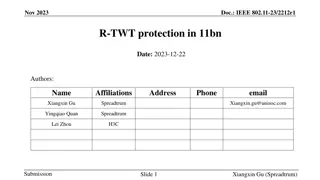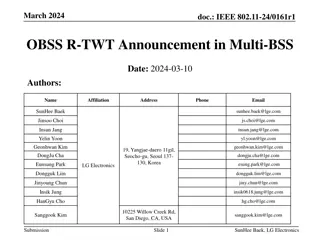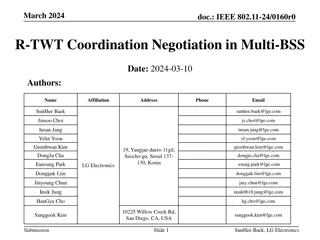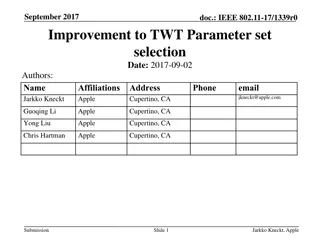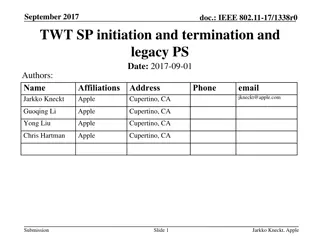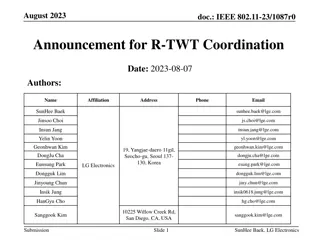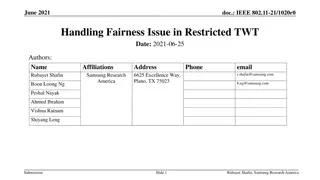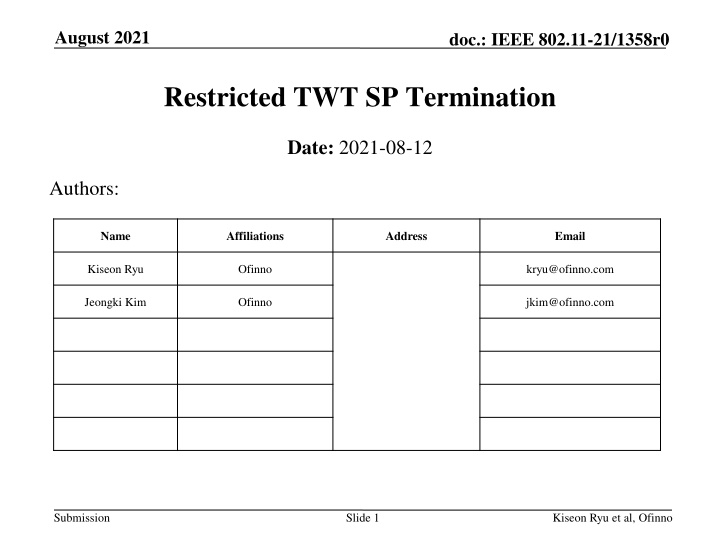
IEEE 802.11-21/1358r0: Methods for Efficient TWT SP Termination in Wireless Networks
Explore innovative methods proposed in IEEE 802.11-21/1358r0 to efficiently terminate restricted TWT SPs in wireless networks, enhancing resource utilization and lowering latency for scheduled STAs. Learn about TWT SP termination criteria, handling fairness issues, and transitioning STAs to doze states in this insightful documentation.
Download Presentation

Please find below an Image/Link to download the presentation.
The content on the website is provided AS IS for your information and personal use only. It may not be sold, licensed, or shared on other websites without obtaining consent from the author. If you encounter any issues during the download, it is possible that the publisher has removed the file from their server.
You are allowed to download the files provided on this website for personal or commercial use, subject to the condition that they are used lawfully. All files are the property of their respective owners.
The content on the website is provided AS IS for your information and personal use only. It may not be sold, licensed, or shared on other websites without obtaining consent from the author.
E N D
Presentation Transcript
August 2021 doc.: IEEE 802.11-21/1358r0 Restricted TWT SP Termination Date: 2021-08-12 Authors: Name Affiliations Address Email Kiseon Ryu Ofinno kryu@ofinno.com Jeongki Kim Ofinno jkim@ofinno.com Submission Slide 1 Kiseon Ryu et al, Ofinno
August 2021 doc.: IEEE 802.11-21/1358r0 Abstract For supporting lower latency traffic, the restricted TWT(r-TWT) is defined in 11be If the allocated r-TWT SP is not used for scheduled STAs, the allocated resource will be wasted In this contribution, we propose the method to terminate the assigned r-TWT SP in case that the r- TWT SP is not used Submission Slide 2 Kiseon Ryu et al, Ofinno
August 2021 doc.: IEEE 802.11-21/1358r0 11ax TWT SP termination In 11ax spec, when a TWT SP termination is detected by a STA within the TWT SP, the STA may transition to the doze state A STA can classify any of following events as a TWT SP termination The transmission by the STA of an acknowledgment in response to an individually addressed QoS Data or QoS Null frame sent by the AP that had the EOSP subfield equal to 1 The transmission by the STA of an acknowledgment in response to an individually addressed frame that is neither a QoS Data frame nor a QoS Null frame, sent by AP with the More Data field equal to 0. The reception of an individually addressed or broadcast QoS Data or QoS Null frame sent by the AP, that does not solicit an immediate response and with the EOSP subfield equal to 1. The reception of an individually addressed frame that is neither a QoS Data frame nor a QoS Null frame, sent by the AP, that does not solicit an immediate response and with the More Data field equal to 0 . Slide 3 Submission Kiseon Ryu et al, Ofinno
August 2021 doc.: IEEE 802.11-21/1358r0 21/1020, Handing Fairness Issue in R-TWT STA can report its buffer for lower latency traffic to the scheduling AP Queue size =0 indicates empty buffer If the AP receives BSR from a scheduled STA indicating empty buffer for latency-sensitive traffic, the scheduling AP can terminate the restricted T WT SP for that particular scheduled STA AP can transmit an individually addressed QoS Data or QoS Null frame with EOSP subfield equal to 1 AP can send an individually addressed frame with More Data field set to 0 If the AP receives BSR from all scheduled STAs indicating empty buffer for latency-sensitive traffic, and if downlink buffers corresponding to latency sensitive traffic for all STAs are also empty, then the scheduling AP can terminate the restricted TWT SP for all scheduled STAs AP can transmit a broadcast QoS Data or QoS Null frame with EOSP subfield equal to 1 Submission Slide 4 Kiseon Ryu et al, Ofinno
August 2021 doc.: IEEE 802.11-21/1358r0 Motivation The allocated r-TWT SP may not be used in one of the following situations The power saving STA does not wake up to receive the Beacon frame including the r-TWT SP info The power saving STA does not need to wake up every Beacon time but at least once within Listen Interval The STA fails to decode the Beacon including r-TWT SP info correctly due to OBSS interference The scheduled STA does not have any buffered data to be sent during the r-TWT SP If the allocated r-TWT SP is not used by the scheduled STA, the resource will be wasted. r-TWT SP TWT element BlockAck BlockAck Beacon Not used for Tx of LS TID data frame AP STA1 does not receive a Beacon frame Not used for Tx of LS TID data frame STA1 (w/ Data of LS TID) Data with non-LS TID Data with non-LS TID STA2 (w/ Data of non-LS TID) STA2 receives a Beacon frame Data Tx of non-LS TID may be deprioritized or restricted Waste of radio resources STA2 stops transmission before r-TWT SP Submission Slide 5 Kiseon Ryu et al, Ofinno
August 2021 doc.: IEEE 802.11-21/1358r0 Proposal If an AP or an STA determines the channel not being used during an r-TWT SP, the AP or the STA may terminate the r-TWT SP by an implicit or an explicit signaling method. Determining the channel not being used can be based on one of the followings. Carrier sensing or frame detection during a certain time period If the result of carrier sense indicates idle or if a frame is not detected, the r-TWT SP may be terminated. A Trigger frame such as an MU-RTS Trigger frame, a BSRP Trigger frame, a Basic Trigger frame, etc. If an AP that sent a Trigger frame at the beginning of an r-TWT SP does not receive any response frame from STAs, the AP may terminate the r-TWT SP. For implicit method, If determining the channel not being used during an r-TWT SP, an AP or an STA may transmit a data frame with a non-LS TID without any restriction or de-prioritization during the remaining r-TWT SP. For explicit signaling method, If determining the channel not being used during an r-TWT SP, an AP may send one of the following frames to indicate termination of the r-TWT SP to STAs. A QoS Null frame with an EOSP field set to 1 QoS Data/Null with a newly defined A-Control field indicating r-TWT SP termination An STA receiving a frame indicating termination of the r-TWT SP may terminate the r-TWT SP and may transmit a data frame with a non-LS TID without any restriction or de-prioritization. Submission Slide 6 Kiseon Ryu et al, Ofinno
August 2021 doc.: IEEE 802.11-21/1358r0 Conclusion The r-TWT SP The allocated r-TWT SP may not be used by the scheduled STA(s) in some scenarios The scheduled STA does not get the r-TWT information due to power saving operation or the failure of Beacon reception Or, the STA may not have buffered UL data to be sent during the r-TWT SP We proposed two methods to terminate the current r-TWT SP In implicit method, an STA or an AP may check whether the medium is not used by a scheduled STA during a certain period within a r-TWT SP. If the STA or the AP determines the wireless medium not being used, the STA or the AP may terminate the r-TWT SP. In explicit method, the AP may send a frame indicating the r-TWT SP termination if the AP determines the medium not being used during an r-TWT SP Submission Slide 7 Kiseon Ryu et al, Ofinno



